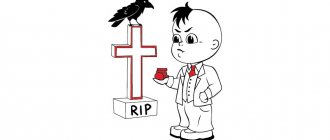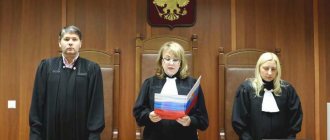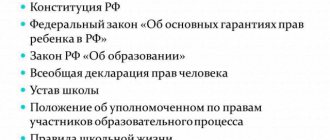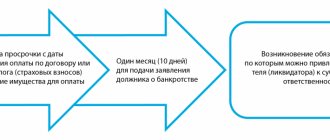Home / Inheritance / Are debts and loans of parents transferred to children
Applying for a loan is not only about attracting additional financial resources, but also about acquiring obligations. Credit legal relations presuppose that each citizen acts on his own behalf and personally fulfills his obligations, including those related to the delay and impossibility of repaying the debt.
But there are also exceptions provided for by law, when liability for debts is assigned to other citizens. In this article we will look at whether loans are transferred from parents to children?
Can financial obligations be inherited?
Along with property, the heir may receive financial obligations from the deceased. Loans, microloans, utility debts or taxes can be inherited. It is important that the heir is liable for the debts of the deceased only within the amount of the inheritance received. For example, if you received property worth 700 thousand rubles, and the amount of debt is a million rubles, then you are liable for debts only within 700 thousand. The remaining 300 thousand in this case is written off by the creditor. If the deceased has several heirs, then in general terms the debts are distributed among them and each is responsible in proportion to the share of the inheritance received. However, each specific case, regardless of the number of heirs, may have its own nuances. You can waive the debts of the deceased before entering into an inheritance, but in this case you will have to renounce everything else (property, deposits, etc.).
Imposition of subsidiary liability on children and heirs of persons controlling the debtor
7.01.20
M. Poluektov / AK Poluektova and partners
At the end of 2021, the Supreme Court of the Russian Federation (hereinafter referred to as the Supreme Court of the Russian Federation) considered two high-profile cases:
— on the transfer to the heirs of the controlling debtor of the person (hereinafter referred to as the CDL) of his debt under subsidiary liability and
— on imposing subsidiary liability on the children of the CDL to whom the CDL transferred its assets free of charge.
Both of these cases received widespread press coverage and mixed reviews from the legal community. Let's look at these cases in more detail.
The case of the transfer of debt under subsidiary liability to the heirs of the KDL (Determination of the SKES of the Armed Forces of the Russian Federation dated December 16, 2019 No. 303-ES19-15056)
The plot of the case: due to the illegal actions of the deputy head of the debtor M.A. Shefer, who died as a result of an accident, the debtor (Amur Product LLC) lost oil products worth 183 million rubles, which were transferred to him for storage. The debtor's loss of petroleum products led to his bankruptcy.
As part of the debtor's bankruptcy case, the creditor filed an application for subsidiary liability and asked to recover 273 million rubles from the debtor's bankruptcy estate. jointly and severally in a subsidiary manner for the debts of the debtor with the former head of the debtor Rudenko S.M. in full; from the heirs of his deputy Schaefer M.A. within the hereditary mass.
The courts of the first three instances brought to subsidiary liability only the former head of the debtor S.M. Rudenko. for bringing the debtor to bankruptcy, since he did not exercise proper control over the actions of his representative (Shefer M.A.), which as a result led to the disposal of petroleum products from the control of the debtor.
In satisfying the demands to bring to justice the heirs of Shefer M.A. the courts refused due to the fact that these requirements are inextricably linked with the personality of M.A. Shefer, and according to Article 1112 of the Civil Code, responsibilities that are inextricably linked with the personality of the testator are not included in the inheritance.
The courts also pointed out that subsidiary liability to creditors for bringing to bankruptcy cannot be considered as tortious liability, since it is additional within the meaning of Article 399 of the Civil Code.
The Supreme Court of the Russian Federation canceled these judicial acts, pointing out the following:
1. Vicarious liability for the obligations of the debtor (insolvent person) arises in connection with damage to the property rights of creditors of the controlled person and is a tort.
. This was stated in paragraph 2 of the Resolution of the Plenum of the Supreme Court of the Russian Federation dated December 21, 2017 N 53 “On some issues related to holding persons controlling the debtor liable in bankruptcy.” It follows from this that a debt arising from subsidiary liability must be subject to the same legal regime as other debts related to compensation for damage to the property of participants in the turnover (Article 1064 of the Civil Code).
2. The application of the provisions of Article 399 of the Civil Code to subsidiary liability in bankruptcy is erroneous. Despite the same name, subsidiary liability under the Bankruptcy Law and subsidiary liability under Article 399 of the Civil Code are completely different legal institutions. Article 399 of the Civil Code regulates additional liability, while subsidiary liability provided for by the Bankruptcy Law is the independent (primary) liability of the controlling person for violation of the obligation to act in good faith and reasonably in relation to the creditors of the controlled person.
3. The obligation to compensate for one’s negative behavior, arising as a result of being brought to subsidiary liability, is not inextricably linked with the personality of the testator
. This means that the debt of the testator, which arose as a result of bringing him to subsidiary liability, is included in the inheritance mass and passes to the heirs.
4. Such a claim can be satisfied only within the limits of the value of the inherited property
(Clause 1 of Article 1175 of the Civil Code). In this case, it does not matter whether the property that was acquired by the testator at the expense of creditors as a result of illegal actions that entailed subsidiary liability was directly included in the estate.
These conclusions of the RF Armed Forces seem absolutely correct.
At the same time, the statements of some authors that the RF Armed Forces allegedly allowed heirs to be held accountable for acts that they did not commit are incorrect.
The heirs are not held responsible for what they did not do. Responsibility lies with the testator (testator) for the offense committed by him. The debts of this CDL are transferred to the heirs and only within the limits of the value of the inherited property. In the same way, the testator's debts for other torts (for example, for damage caused as a result of an accident) are transferred to the heirs.
This statement is also true in the case when a claim for subsidiary liability is filed after the death of the CDL to his heirs. The fact is that the debts of the testator are understood not only as obligations that have come due, but also all other obligations of the testator that do not end with his death and are transferred in the order of universal succession. In this case, by its legal nature, the subsidiary debt of the CDL passes to the heirs, even if it is established after his death. The heirs themselves are not recognized as CDL at any time.
The only thing that confuses this story is the extension to the heirs of the presumptions of bringing the debtor to bankruptcy provided for by the Bankruptcy Law (about these presumptions, see our article “How a creditor can collect money from a bankrupt. Part II. Vicarious and other liability of persons controlling the debtor”).
These presumptions were introduced taking into account the fact that the CDL has all the information about the debtor and, if possible, will be able to refute them (transfer the missing documents to the arbitration manager).
Obviously, due to the lack of involvement of the heirs in the affairs of the debtor, it will be difficult for them to refute these presumptions, which may entail the satisfaction of a claim for subsidiary liability without sufficient grounds.
Thus, it will be difficult for the heirs to prove that the debtor’s bankruptcy was caused solely by external factors and not by the actions of the testator, that his actions did not go beyond the normal business risk and were not aimed at violating the interests of creditors, or that the actions imputed to him were committed to prevent even worse damage to creditors.
Realizing this problem, the Supreme Court of the Russian Federation indicated that after the death of the testator, the heirs do not always have the opportunity to explain the reasons for the testator’s management decisions; they, as a rule, do not have a full set of evidence that the testator could have presented if he had not died. Consequently, the courts need to provide assistance in obtaining evidence in accordance with the rules of Part 4 of Article 66 of the APC.
Nevertheless, the mere indication of the RF Armed Forces on the need to provide assistance in obtaining evidence seems insufficient.
It would be fair to apply these presumptions in a limited manner, taking into account the real possibilities of the heirs to present evidence to rebut these presumptions within a particular case.
The case of imposing subsidiary liability on the children of a CDL to whom this CDL transferred its assets free of charge (Determination of the SKES of the Armed Forces of the Russian Federation dated December 23, 2019 No. 305-ES19-13326)
Alliance LLC (the debtor), being a contractor under government contracts, signed fictitious subcontract agreements with organizations under its control to reduce its tax burden. In reality, no work was performed by subcontractors. However, payments in favor of these fictitious subcontractors allowed the debtor to receive an unjustified tax benefit in the form of an unreasonable reduction in the tax base for income tax and an increase in tax deductions for VAT.
The director and majority shareholder of the debtor was V.I. Samylovskikh.
His wife Kirienko N.A. directly participated in the activities of fictitious subcontractors used by the debtor (in one organization she was a manager, in another an accountant, in a third she advised the director on tax issues). She was also the director and sole participant of Veksha Plus LLC, to whose accounts funds hidden by the debtor from taxation were unreasonably redirected.
Based on the results of the tax audit, the debtor was assessed additional income tax and VAT in the total amount of 208 million rubles, and also imposed a fine in the amount of 69 million rubles.
After a tax audit of the wife of Samylovsky V.I. and Kirienko N.A. transferred their expensive property free of charge on the basis of gift agreements to their children. At the time of the tax offense, the children were minors, and at the time of the donation, one son was 15 years old and the other was 20 years old.
The Federal Tax Service filed an application for bankruptcy of the debtor and, as part of this case, demanded that the director and majority participant of the debtor V.I. Samylovskikh, his wife N.A. Kiriyenko, and their minor sons, Daniil Samylovskiy and Dmitry Samylovskiy, be brought to subsidiary liability.
The court of first instance brought to subsidiary liability only the head of the debtor V.I. Samylovskikh, collecting 311 million rubles from him into the bankruptcy estate.
The appellate court changed the ruling of the first instance court, recognized the wife of the debtor’s manager (N.A. Kiriyenko) as a CDL and additionally brought her to subsidiary liability in the same amount.
The Court of Cassation overturned the appeal ruling, indicated that there were no grounds for recognizing the spouse as a controlling person, and upheld the ruling of the first instance court.
All three authorities found no grounds for holding children vicariously liable.
The matter reached the RF Armed Forces, which came to the following conclusions:
1. The head of the debtor is subject to subsidiary liability, since he created the above-described business model, which led to the bankruptcy of the debtor.
2. The wife of the debtor’s manager (Kirienko N.A.) is also subject to subsidiary liability, since she took part in the actions that led to the debtor’s bankruptcy.
The actions of the spouses were agreed upon, coordinated, aimed at realizing a common unlawful intention.
According to Article 1080 of the Civil Code (this article is contained in Chapter 59 of the Civil Code “Obligations resulting from causing harm”, and the Plenum of the Supreme Court of the Russian Federation in Resolution No. 53 directly indicated the need to apply the provisions of this chapter when bringing the CDL to subsidiary liability) “persons who jointly caused harm, are responsible to the victim jointly.” Therefore, the spouse is subject to joint and several liability as a co-injurer of harm.
.
3. The dispute regarding bringing children to subsidiary liability should be sent for a new trial to the court of first instance, and when resolving this dispute, the following must be taken into account.
Children, being minors during the period when illegal actions took place, were not CDL and are not subject to liability
for bringing the debtor to bankruptcy
. The presumption of a controlling beneficiary is not applicable to them (subclause 3, clause 4, article 61.10 of the Bankruptcy Law).
At the same time, children can be used by parents as a tool to hide property belonging to the parents from foreclosure. In particular, parents can formalize the transfer of ownership of property to their children only for show, without the intention of creating corresponding legal consequences, thereby completing an imaginary transaction, which, by virtue of clause 1 of Article 170 of the Civil Code, is void.
But even if the court comes to the conclusion that there are no signs of sham in the transaction, the possibility of applying liability measures is not excluded on the basis of Article 1064 of the Civil Code.
Harm to creditors can be caused not only by bringing the debtor to bankruptcy, but also by deliberate actions aimed at making it impossible for creditors to obtain full satisfaction from the property of the CDL
, guilty of bankruptcy of the debtor, including through the acquisition of their property by relatives under real gratuitous transactions that are not imaginary, the harmful purpose of which could not have been unknown to the acquirer.
In this case, compensation for damage caused to creditors is limited in amount to the value of the property.
, although the owner has changed, but, in fact, left in the family (Article 1082 of the Civil Code).
Despite the fact that the grounds for the creditors' claims against controlling persons (creating the necessary reasons for bankruptcy) and the relatives who acquired their property (creating the impossibility of full fulfillment at the expense of the property of the controlling persons) do not coincide, the creditors' claims against them pursue a single goal - to compensate in full for losses ( Article 15 of the Civil Code), therefore, the obligations of the controlling persons and the mentioned relatives are joint and several (Article 1080 of the Civil Code), which also makes it possible to exclude the occurrence of unjust enrichment on the side of the injured creditors.
During the period when the donation agreements were concluded, one son was an adult, and the other was 15 years old. By virtue of paragraph 3 of Article 26 and Article 1074 of the Civil Code, minors aged 14 to 18 years are responsible for the harm they cause.
The lower courts did not check whether the children became the real owners of the property donated by their parents, and whether, by receiving the property as a gift, along with acquiring ownership rights, they pursued another goal - to free this property from foreclosure by their parents' creditors for tortious obligations
.
When reconsidering the dispute, the court should consider the possibility of holding children accountable for intentional actions aimed at making it impossible for the debtor’s creditors to obtain execution at the expense of their parents’ property
.
This case is not as clear as the previous one and has met with great criticism from lawyers, but nevertheless, the conclusions of the RF Armed Forces seem correct.
And most importantly, the ruling of the RF Supreme Court is fair. Justice is what our judicial system, which still suffers from excessive formalism, lacks. In this case, the RF Supreme Court found a fair solution and, no less important, managed to justify it with references to positive law.
What should you pay attention to when analyzing this Determination of the RF Armed Forces?
The wife of the debtor's manager (N.A. Kiriyenko) was not recognized as a CDL (in any case, the RF Supreme Court did not speak out about this), but was nevertheless brought to subsidiary liability.
We believe that the Supreme Court of the Russian Federation brought the spouse to subsidiary liability not as a person controlling the debtor, but as his accomplice - a “co-causer of harm” on the basis of Article 1080 of the Civil Code, according to which “persons who jointly caused harm are jointly and severally liable to the victim.”
Probably the Supreme Court of the Russian Federation reasoned as follows: if a CDL is subject to subsidiary liability for a tort, then other persons, although not a CDL, but who are “co-injurers of harm,” must be jointly and severally liable with the CDL.
The same approach was applied to children.
Minor children are not CDLs, and therefore are not subject to subsidiary liability for bringing the debtor to bankruptcy, the RF Armed Forces indicated.
But they may be held liable for another tort - for the fact that, when they were already 14 years old, they knowingly participated in hiding the property of their parents from the claims of creditors. And this is precisely how children could harm their parents’ creditors.
Therefore, the Supreme Court of the Russian Federation pointed out the need to believe whether children, by accepting property as a gift, pursued an unlawful goal - to hide the property of their parents from foreclosure on their tortious obligations (how such a goal can be proven in practice is not entirely clear).
Obviously, this approach should be applied not only to the children of the CDL, but to any gratuitous or imaginary purchasers of property that creditors could foreclose on.
At the same time, the Supreme Court of the Russian Federation especially noted that the amount of liability of such donees is limited by the value of the property donated to them, which is quite fair (an analogy with the previous case suggests itself, in which the heirs are liable within the value of the inherited property).
Many critics of the considered definition of the RF Supreme Court point out that in this case, the appropriate way to protect the violated rights of creditors was to challenge gift transactions either under clause 1 of Article 170 of the Civil Code (an imaginary transaction), or in accordance with Chapter III.1. Bankruptcy Law, or under Article 10, 168 of the Civil Code. In their opinion, the Supreme Court of the Russian Federation should not have allowed competition of claims and allowed the filing of a claim to bring children to subsidiary liability.
Meanwhile, in the order of Chapter III.1. According to the Bankruptcy Law, such gift agreements cannot be challenged, since the debtor (Alliance LLC) did not give anything to the children, their parents did.
According to the above articles of the Civil Code, gift transactions can theoretically be challenged, but will this method of protection be effective for the debtor’s creditors?
Unfortunately, in our legal system, a Paulian claim, if considered outside the framework of a bankruptcy case, has not yet become an effective method of defense. Courts often refuse to grant it. And if they do, then difficulties often arise with the execution of the court decision, since it is necessary for one opponent of the plaintiff (son) to return the donated property (or, if it was disposed of, its value) to another opponent of the plaintiff (parent).
In addition, a claim against children and parents to challenge gift agreements can be filed only after a judicial act bringing parents to subsidiary liability has entered into legal force. And by this moment, both the property donated to the children and other assets they have can already be irrevocably removed from their property and transferred to other persons. In this case, you can hardly count on the actual execution of the court decision.
Whereas, in the context of a dispute about bringing to subsidiary liability, it is much easier at an earlier stage to achieve the adoption of interim measures aimed at preventing the withdrawal of assets from the property of children.
The only thing that cannot be understood from the Determination of the Armed Forces of the Russian Federation is what would happen if the children were minors at the time of the donation and they clearly could not have had the unlawful purpose of helping their parents hide the property from foreclosure? What if parents used their young children as a tool to hide assets?
We believe that in such cases there are no grounds for holding children vicariously liable. But such transactions should a priori be recognized as void as imaginary. In this case, the property must be returned to the parents through restitution.
But a more elegant solution is possible. According to Article 77 of the Federal Law “On Enforcement Proceedings,” foreclosure on the debtor’s property held by third parties is carried out on the basis of a judicial act.
Guided by this article, the bankruptcy trustee of the debtor, after bringing the parents to subsidiary liability, can immediately file a claim to foreclose on the property of the parents held by the children. The legal basis for the claim is as follows: gift transactions are void as imaginary (clause 1 of Article 170 of the Civil Code); to recognize a void transaction as invalid, no special court decision is required (clause 1 of Article 166 of the Civil Code); since the transactions are invalid, they did not entail legal consequences in the form of transfer of ownership of the children, the parents continue to remain the owner of the property (clause 1 of Article 167 of the Civil Code); If the parents are the owners of the property, then their debts can be used to foreclose on this property.
How to find out the amount of debt
- First of all, you need to contact a notary who is handling the inheritance matter. He, in turn, will send requests to the BKI, bailiffs and the tax office. If you know where the deceased took out loans, this simplifies the matter: the notary will send requests to specific organizations. Sometimes it happens that lenders contact relatives or potential heirs themselves when the borrower stops paying. But this occurs when the deceased person left the contacts of loved ones for communication and their consent was obtained to use the data in an emergency.
- The next step that must be taken is to carefully study the loan documents. It often happens that the loan taken was insured, and in the event of the death of the borrower, the insurance company is obliged to pay the debt to the lender.
How to pay off financial obligations inherited
Lenders have the right to charge interest on loans even after the death of the borrower. In order to avoid fines and penalties, immediately after the death of a relative, it is recommended to contact a financial institution and ask not to charge fines until the inheritance is accepted. You can demand repayment of the debt only after the heirs have officially entered into the inheritance. Until this moment, loan payments can be “frozen”, that is, the payment schedule will be shifted. It is necessary to confirm the death of the borrower by providing the appropriate certificate. There are often cases when the amount of payments is too large for the heir. In this situation, it is best to communicate with the creditor and, if possible, change the terms of payment of the debt. For example, the EOS agency almost always meets halfway requirements for its clients: we can change the payment schedule, refinance the loan, or even write off part of the debt. We value partnerships and put the comfort of our clients first.
Where did the misinformation come from?
Some time ago, debtors were literally bombarded by collection agencies with similar threats. There is nothing more effective than psychological influence on the debtor. If the debtor is also a parent, then the task is simplified several times: it is enough to mislead the person and threaten to deprive the child of the child, and the process gets off the ground (in most cases).
Some collection agencies went even further and began to threaten debtors that after their child was taken away from them, he would be transferred to be raised by another, “more prosperous” family. This has nothing to do with reality and the law.
Credit debtors are required to know in the form of a memo: only a court can deprive a citizen of parental rights (the grounds are indicated above). Before deprivation, a lot of work is carried out, with the participation of territorial guardianship and trusteeship authorities. Moreover, this is an extremely lengthy process that drags on for a year or more.
We have also prepared a review especially for you: How to legally avoid paying a loan and start living in peace
Therefore, such threats from debt collectors or bank employees should not be taken seriously. This is disinformation aimed at psychological pressure on the debtor, which, unfortunately, very often turns out to be effective.







